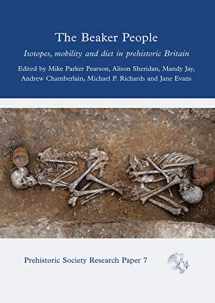
The Beaker People: Isotopes, Mobility and Diet in Prehistoric Britain (Prehistoric Society Research Papers)
ISBN-13:
9781789250640
ISBN-10:
1789250641
Edition:
First Edition
Author:
Mike Parker Pearson, Alison Sheridan, Mandy Jay, Andrew Chamberlain, Jane Evans
Publication date:
2019
Publisher:
Oxbow Books
Format:
Hardcover
616 pages
Category:
Great Britain
,
European History
FREE US shipping
Book details
ISBN-13:
9781789250640
ISBN-10:
1789250641
Edition:
First Edition
Author:
Mike Parker Pearson, Alison Sheridan, Mandy Jay, Andrew Chamberlain, Jane Evans
Publication date:
2019
Publisher:
Oxbow Books
Format:
Hardcover
616 pages
Category:
Great Britain
,
European History
Summary
The Beaker People: Isotopes, Mobility and Diet in Prehistoric Britain (Prehistoric Society Research Papers) (ISBN-13: 9781789250640 and ISBN-10: 1789250641), written by authors
Mike Parker Pearson, Alison Sheridan, Mandy Jay, Andrew Chamberlain, Jane Evans, was published by Oxbow Books in 2019.
With an overall rating of 3.7 stars, it's a notable title among other
Great Britain
(European History) books. You can easily purchase or rent The Beaker People: Isotopes, Mobility and Diet in Prehistoric Britain (Prehistoric Society Research Papers) (Hardcover) from BooksRun,
along with many other new and used
Great Britain
books
and textbooks.
And, if you're looking to sell your copy, our current buyback offer is $2.05.
Description
The Beaker People: isotopes, mobility and diet in prehistoric Britain presents the results of a major project that sought to address a century-old question about the people who were buried with Beakers a – the distinctive pottery of Continental origin that was current, predominantly in equally distinctive burials, in Britain from around 2450 BC. Who were these people? Were they immigrants and how far did they move around? What did they eat? What was their lifestyle? How do they compare with Britain’s earlier inhabitants and with contemporaries who did not use Beaker pottery? An international team of leading archaeologists and scientists, led by Professor Mike Parker Pearson, was assembled to address these questions. Around 300 skeletons were subjected to isotope analysis to explore patterns of mobility and diet, and 150 new radiocarbon dates were obtained. Dental microwear was examined for 64 individuals to provide further information about the food they had eaten, and new information on the sex and age of 201 people obtained. A comparative study was undertaken of the shape and size of Beaker users’ skulls and those of Neolithic people in the Peak District of England, to examine the long-held claim that there was a switch from long-headed to round-headed people with the appearance of Beakers. Tantalizing evidence for head-binding among Neolithic people was found. The range of objects found in Beaker graves was reviewed.In addition, the Beaker People Project was able to incorporate the results of another project, focusing on Beaker users in north-east Scotland (The Beakers and Bodies Project) along with other recently obtained data, including ancient DNA results. Overall, new light has been shed on 369 people: 333 Beaker and non-Beaker users from the core 2500–1500 BC period, along with 17 from the Neolithic and 19 from after 1500 BC. While the genetic data provide convincing evidence for immigration by Continental Beaker users, the isotopic data indicate a more detailed picture of movements, mostly of fairly short distances within Britain, by the descendants of the first Beaker users. This lavishly illustrated book presents a body of data that will be vital to studies of Chalcolithic and Early Bronze Age Britain for decades to come.Table of ContentsList of Figures and TablesContributorsAbstractFrench Language AbstractGerman Language AbstractAcknowledgementsNotes about radiocarbon dates and the use of the term ‘east Yorkshire’1. IntroductionBy Mike Parker Pearson, Mandy Jay and Alison Sheridan2. Radiocarbon dates and their Bayesian modellingBy Mandy Jay, Michael P. Richards and Peter Marshall3. Economy and society in Beaker-period BritainBy Mike Parker Pearson4. The Beaker People Project individuals, their funerary practices and their grave goodsBy Mike Parker Pearson, Stuart Needham and Alison Sheridan with Alex Gibson5. Beakers and bodies in north-east Scotland: a regional and contextual studyBy Neil Curtis and Neil Wilkin, with Margaret Hutchison6. Aspects of human osteology and skeletal biologyBy Chris A. Deter, Patrick Mahoney, Sarah E. Johns and Sandra Thomas7. Dental microwear: 2D and 3D approachesBy Patrick Mahoney, Laura Chiu, Pia Nystrom, Chris A. Deter and Christopher W. Schmidt8. Carbon and nitrogen isotopic analysisBy Mandy Jay and Michael P. Richards9. Sulphur isotopic analysisBy Mandy Jay, Olaf Nehlich and Michael P. Richards10. Strontium isotopic analysisBy Janet Montgomery, Jane Evans and Jacqueline Towers11. Oxygen isotopic analysisBy Maura Pellegrini, Mandy Jay and Michael P. Richards12. Synthesis, discussion and conclusionsBy Mike Parker Pearson, Mandy Jay, Janet Montgomery, Alison Sheridan and Stuart NeedhamBibliographyAppendicesAppendix 1. The pre-2500 BC individualsBy Mandy Jay, Janet Montg omery, Mike Parker Pearson and Alison SheridanAppendix 2. The post-1500 BC individualsBy Mandy Jay, Janet Montg omery, Mike Parker Pearson and Alison SheridanAppendix 3. Details of findspot location, current location of the human remains and bibliographicreferences for the skeletal material studied by the Beaker People ProjectBy Mandy Jay and Alison SheridanAppendix 4. Location group, period, incidence of association with Beaker or Food Vessel and sexand age identificationsBy Mandy Jay and Alison SheridanAppendix 5. Analytical and dating work undertaken for the Beaker People Project and the Beakers andBodies Project (plus other data used by these projects)By Mandy Jay and Alison SheridanAppendix 6. Part 1. Details of the individuals studied in the Beakers and Bodies Project: findspot,identifier, NGR, find date, associations and radiocarbon datesPart 2. Osteological information and data on orientation and disposition in the graveof individuals studied in the Beakers and Bodies ProjectBoth By Margaret HutchisonIndex


We would LOVE it if you could help us and other readers by reviewing the book
Book review

Congratulations! We have received your book review.
{user}
{createdAt}
by {truncated_author}


